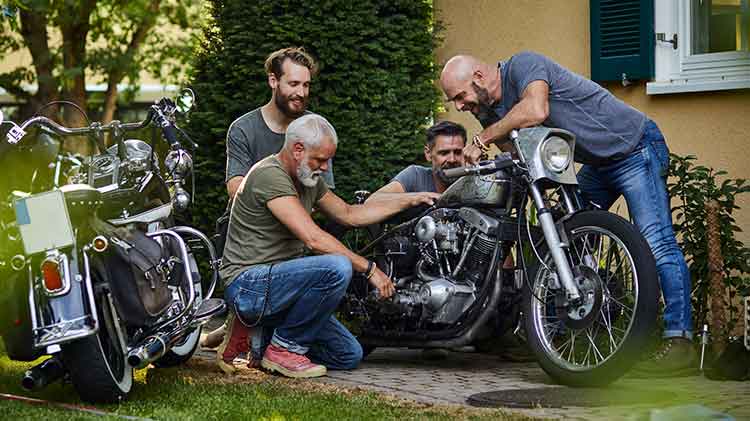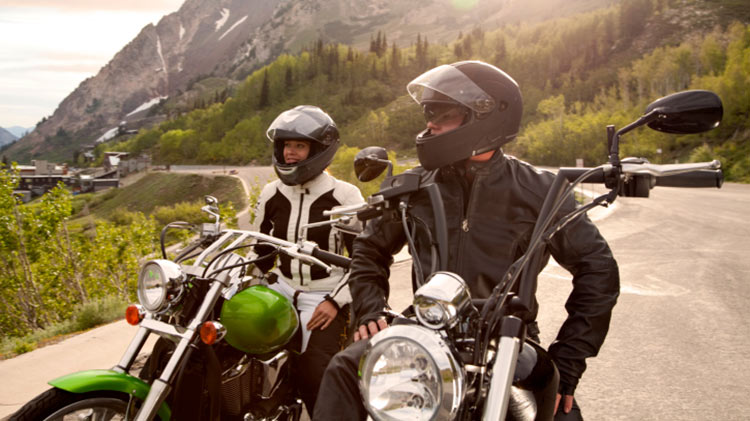Motorcycle insurance cost for new or vintage rides
Insurance costs can vary whether your motorcycle is new, used, classic or antique.
Motorcycle insurance costs can vary based on the age and type of bike you have. Generally, new motorcycles cost more to insure than used ones due to higher replacement costs. However, new motorcycle safety features like ABS can help reduce premiums. Vintage bikes can also have high premiums, especially if it’s considered a classic or antique.
Similar to auto insurance, the cost of motorcycle insurance partially depends on the type of motorcycle you are insuring. Factors such as safety features, loss experience, theft rate, replacement cost and the age of the bike are also used in determining the cost of your motorcycle insurance. If a vintage bike has been restored with exceptional workmanship or maintained and preserved in its original condition or is undergoing a restoration by an antique automobile hobbyist, it may qualify as a classic or antique (eligibility will vary by insurance carrier and state).
When is a bike considered classic, vintage or antique motorcycle?
Insurers may use various criteria to classify a motorcycle as classic, vintage or antique. Generally, a bike is considered classic, vintage or antique if it is at least 20 years old and well-maintained. However, some insurers may classify a bike as vintage if over 25 years old, and an antique motorcycle if it’s over 35 years old. When insuring a classic, vintage or antique bike, the process can be similar to insuring a classic car, such as:
- A classic motorcycle should look like it just rolled off the manufacturing line. Some modifications may be acceptable. Your custom “classic” bike might still qualify if it was rebuilt with fabricated parts.
- A classic or antique motorcycle must be used on an occasional basis, such as infrequent pleasure driving, shows, exhibitions, club activities or parades.
- You need to have restored, maintained or preserved your classic or antique motorcycle or it must be actively undergoing restoration. Keep in mind some insurers may decline coverage if the bike is not in excellent condition.
- Also, be prepared for an insurer to require you to keep your motorcycle stored in an enclosed building. Consider keeping it stored somewhere securely locked to help prevent damage and theft.
Have an agent contact me
with a quote
What insurance coverages are available for motorcycles?
Whether you ride regularly or on weekends, you will need motorcycle insurance to ride legally in most states. You may want to check with your insurance agent to confirm your policy includes:
- Bodily injury and property damage liability — these insurance options pay for injuries or damage to other people or their property while you are riding. Motorcycle liability insurance is required in most states.
- Comprehensive and collision — these coverages pay the cost to repair or replace your bike if it is damaged or stolen. If you have a lienholder, they will likely require these coverages. Inform your agent if any customizations have been made, including a sidecar.
- Medical payments — this can help provide coverage for your medical payments if you get into a crash. This coverage may not be available in all states.
How much is motorcycle insurance?
Classic, vintage or antique motorcycle
Motorcycles can vary in their insurance costs due to factors such as your motorcycle type, your riding history, garaging location and the coverages you select. While classic or antique bikes tend to be less powerful and risky than newer bikes, they can be harder and more expensive to replace or repair. Liability costs may be lower but comprehensive and collision costs might be more. In addition, the make, model and year of the motorcycle impact the price. An older, hard-to-find make and model, may be more expensive to insure than one that is more common.
New motorcycle
Sport bikes are designed for speed, with sleek lines and more powerful engines, which can drive up the cost of liability insurance. Also, touring motorcycles with multiple features can be more expensive to insure because the repair or replacement cost can be high. Generally, the average price of motorcycle insurance can vary depending on the motorcycle’s value.
Insuring a new motorcycle can also be pricier if you take out a loan to buy it. Lienholders typically require comprehensive and collision coverage in addition to the other coverages required in your state.
Used motorcycle
Insurance rates for used motorcycles, that are not considered classic or antique, may be more affordable as value and replacement costs tend to be lower. Also, used motorcycle owners may consider liability-only coverages if they do not have a lienholder.
Like auto insurance, there are factors such as the age of the rider, the garaging location and driving history that can determine your motorcycle insurance premium. When checking for low-cost motorcycle insurance rates, ask your agent if discounts are available for completing motorcycle safety courses.
Should I get my motorcycle appraised?
An appraisal can help document the value of your bike and could be used by your insurance company. Some insurance companies will quote your classic motorcycle using their own internal valuation tools. These, in part, will be based upon pricing guides such as the Kelley Blue Book value or the National Automobile Dealers Association (NADA) motorcycle appraisal guide.
If the price guide value does not match what you think your motorcycle is worth, the insurer might allow for an “agreed value.” Typically, when they do, they will ask for your bike to be appraised by a third party. Once the value is established, the insurer will determine if it’s reasonable.
Does insurance cover my vintage accessories?
Motorcycle gear like jackets, helmets and other accessories are typically covered under the comprehensive and collision part of the policy. However, they may have a limit. This limit is the maximum amount the insurance will pay to replace the items, regardless of their real value. If you have vintage accessories, check with your insurance agent to verify that the amount will cover those items.
If your favorite ride is a vintage motorcycle, an antique rarity or a new cruising bike, ensure you and your motorcycle are covered with insurance that fits your needs. Talk with your insurance agent to help review discounts and policy options that can help protect your ride.




